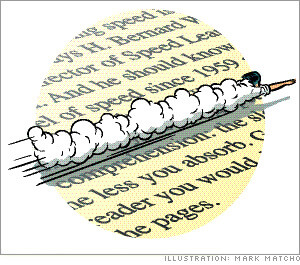What Speed Reading Critics Don’t Understand

What Is Speed Reading?
Speed reading will typically happen in two forms: the Outread and QuickReader method of highlighting groups of words at a preset pace that the reader is then responsible for keeping up with; and the Spritz form known formally as RSVP (Rapid Serial Visual Presentation). RSVP shows users one word at a time at a rapid rate. Spritz tweaks this concept a bit and colors the letter at the ORP (optimal recognition point) differently from the rest of the letters.
The Case Against Speed Reading
In a recent piece for the Atlantic entitled, “Is Speed Reading Possible?,” the author cites multiple research evidence that shows acclaimed “speed readers” are not so good at retaining information.
“In the World Championship Speed Reading Competition,” writes the Atlantic, “top contestants read about 1,000 to 2,000 words per minute, but they only understand about half of what they take in. One study of 16 high performing people, including self-proclaimed ‘speed readers,’ found that none could read faster than 600 words per minute while understanding at least three-quarters of the information.”
There is other similar evidence throughout the piece, but we would argue that these results do not allow for the way that speed reading is actually done when placed in the context of reading for the web or studying.
What Critics Don’t Realize
Critics of speed reading fail to realize that the way speed readers are often “assessed” is only a small part of what the actual speed reading process is good for. They act as if speed readers look at the information once, close the book or shut down the website, and then expect that to be the end of it. That’s hardly the case. While we’ll certainly agree that 2k words per minute is a little iffy, at what point do you define speed reading? Six hundred words per minute on one’s own with 75 percent comprehension is one heck of a start. We certainly think that pace should be considered “speed reading” and being able to comprehend at that level while doing so, is more valuable than reading and comprehending everything at 200 words per minute. Here’s why:
Some Comprehension Is Better Than No Comprehension
Seventy-five percent comprehension may not be acceptable on the surface, but let’s break it down and see what that really means. For starters, it’s a firm foundation of knowledge for the material in question. When you’re bombarded with reading assignments the way you are in college or on a standardized exam, you need to be able to cover information quickly and with a high degree of accuracy. People who read 600 words per minute have managed to achieve three-quarters understanding in a third of the time of the normal reader. This enables them to go back and fill in the gaps of their knowledge with room to spare before the other person ever catches up.
Speed Reading Is An Effective Study Tool
Speed reading is not meant to ensure that we never read another sentence in its entirety ever again. To the contrary, it’s to access and retain information. Being able to cover a lot of ground very quickly is a great way to keep up with your studies as they become more challenging in content and demanding of your time. Also:
Speed Reading, Done Right, Can Lead To Better Engagement
When you take off on a speed reading session, you’re doing so with a bit of a beat-the-clock mentality. That means you’re forcing your brain to perform, and that performance goes well beyond basic reading. It also means that, as you go, you’re taking the word blocks that are breaking through and you’re comparing and contrasting and asking questions of all the information you’ve just gone over. This act of engagement allows your brain to take over for a bit and fill in the gaps that are left by a missed word or phrase.
Speed Reading Is More Than Just Reading
In a testing situation, this can be greatly beneficial because you’re able to outline the passage in your brain as you go. When you get to the end, a question is likely to jog your memory about something you read but may have not fully comprehended. At this point you’re able to go back and take a closer look at the section because you have a general sense of “where things are.”
Think about it like you’re walking into a house you’ve never entered before, but you’re familiar with the layout. You know the house has three bedrooms, two baths, and a family room, but you may not know what magazines they have on their coffee table. Still, you remember seeing a coffee table in the family room when you did your initial walkthrough, so you’re able to go to that room and get a clearer picture in a shorter amount of time than if you started at the front door and took your time learning each room.
In Summary
Speed reading has been around in some form since at least the 1950s, and while some techniques are more effective than others, it really is a fantastic tool for the busy student. Pay no mind to articles that question the validity of the concept, because they fail to realize that the act is part of a larger package. It’s a way to tune your thoughts into the material; to pick up key concepts; to get your brain asking how certain concepts relate to the work as a whole; and to familiarize yourself with structure in a way that allows you to more quickly reference vital clues. With tech apps like the three mentioned at the front of this piece, it’s possible to improve your comprehension speeds and build a foundation that leads to deeper understanding in a third of the time as someone trying it the old-fashioned way. You will dismiss this highly effective study tactic at your own risk.








